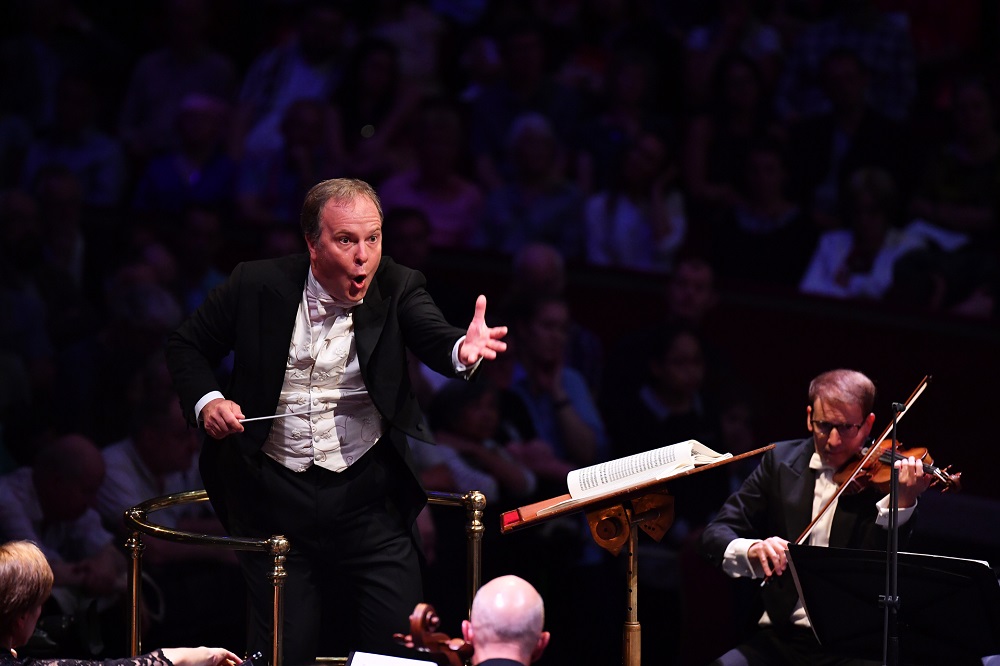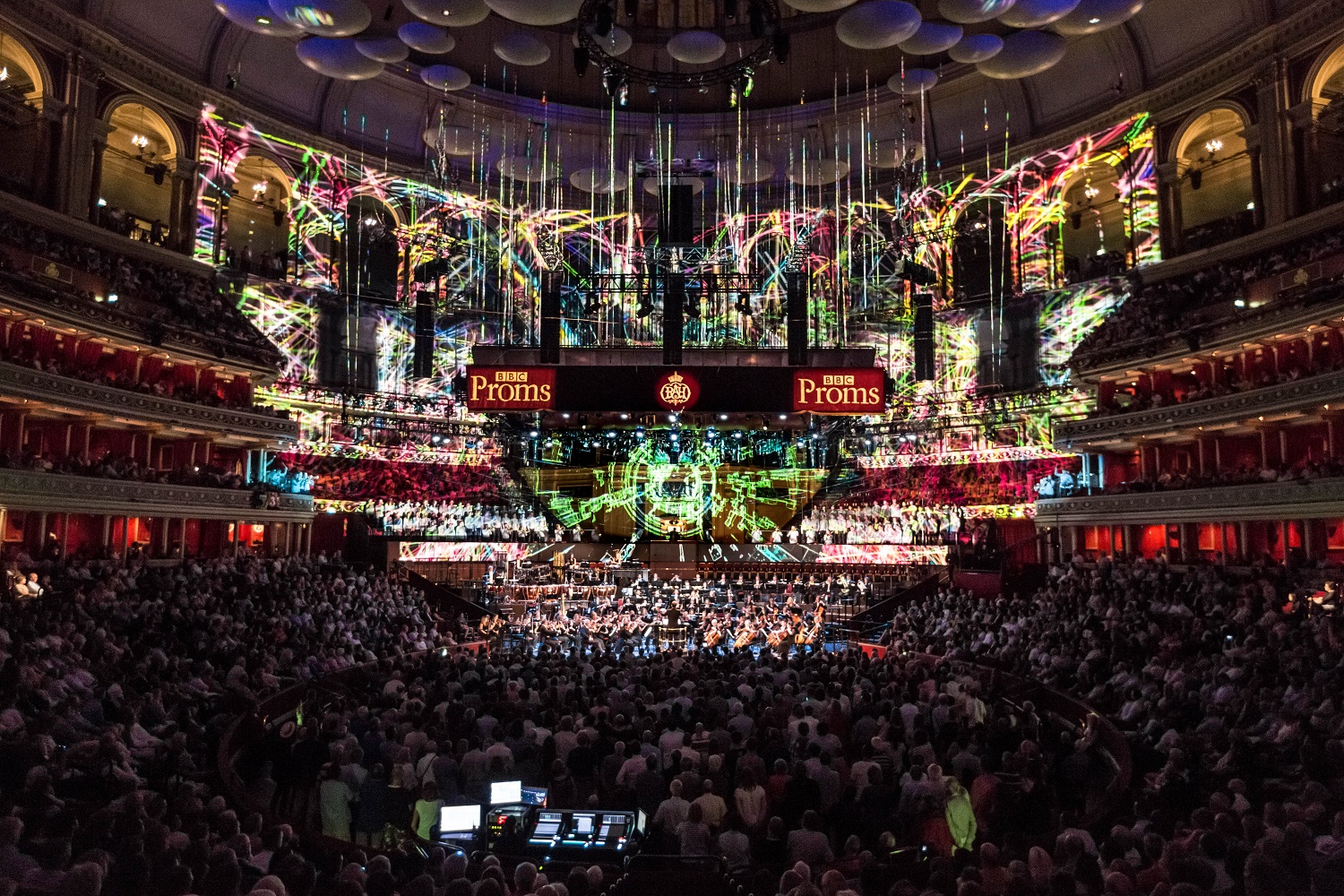Prom 1, BBCSO, Oramo review – spectacular First Night of the Proms | reviews, news & interviews
Prom 1, BBCSO, Oramo review – spectacular First Night of the Proms
Prom 1, BBCSO, Oramo review – spectacular First Night of the Proms
Dynamic but sensitive Holst, multi-media show high on spectacle but low on substance
The First Night of the Proms is always a tricky one to programme, bringing together themes of the season, perhaps a new work and, most importantly, a grand finale. This year’s Prom No. 1 ticked all the boxes, and without feeling like pick-n-mix.
But before all that, a hastily added memorial to Oliver Knussen, who died this week. Knussen was a regular at the Proms, so it was fitting to mark the occasion. In the event, his Flourish with Fireworks would have been the ideal concert opener, with or without his untimely passing. The piece is based on Stravinsky’s Fireworks and similarly short and punchy. It is more varied too, the flourishes of the title coming across as brief asides in different tempos and textures. The ever-prepared BBC Symphony took it all in their stride, with no hint of rushed preparation.
Toward the Unknown Region opens in a darker place, Vaughan Williams setting Walt Whitman, and both in sombre, funereal mood. The BBC Symphony Chorus were on top form here, giving us suitably dark and focussed choral textures, but also clearly articulating the words – just as well as there were no texts provided. Oramo marshalled his large forces efficiently and dynamically, suitably emotive but never sentimental. 
The Anna Meredith work was entitled Five Telegrams, and was written in commemoration of the centenary of the ending of the First World War. The work is a collaboration with 59 Productions, who provided a spectacular light projection, covering the stage, organ, choir stalls and all the space above, right up to the gallery (pictured below by Justin Sutcliffe).  The work’s five movements are entitled “Spin”, “Field Postcard”, “Redaction”, “Codes”, and “Armistice”, but beyond that, Meredith and co. took a highly abstract approach to their subject. Meredith’s music here is tonal and repetition-based, although not to the point of minimalism. She was also writing for the National Youth Choir of Great Britain and the BBC Proms Youth Ensemble, a group of teenaged brass and percussion players, some in the choir stalls, others positioned around the hall. And most effectively, one movement featured a choir of euphoniums, playing mellow chords up in the gallery.
The work’s five movements are entitled “Spin”, “Field Postcard”, “Redaction”, “Codes”, and “Armistice”, but beyond that, Meredith and co. took a highly abstract approach to their subject. Meredith’s music here is tonal and repetition-based, although not to the point of minimalism. She was also writing for the National Youth Choir of Great Britain and the BBC Proms Youth Ensemble, a group of teenaged brass and percussion players, some in the choir stalls, others positioned around the hall. And most effectively, one movement featured a choir of euphoniums, playing mellow chords up in the gallery.
The light show, all computer generated effects and patterns, sometimes including a single evocative word, was skilfully integrated into the architecture of the hall, illuminating the ranks of pipes inside the organ and, in one movement, transforming the arches of the gallery into huge turning cogs. The overall effect was grand, and perhaps a little upbeat given the subject. Meredith’s music was a component in this multimedia work, and the synergy between the light show and the music was close indeed. More substance might have tipped the balance better towards the musical side, especially to the contribution of the orchestra, but it all served its purpose: A memorable start to the season ahead.
- Watch on BBC Two and/or listen on BBC Radio 3 for the next 28 days
- Read more classical music reviews on theartsdesk
rating
Explore topics
Share this article
The future of Arts Journalism
You can stop theartsdesk.com closing!
We urgently need financing to survive. Our fundraising drive has thus far raised £49,000 but we need to reach £100,000 or we will be forced to close. Please contribute here: https://gofund.me/c3f6033d
And if you can forward this information to anyone who might assist, we’d be grateful.

Subscribe to theartsdesk.com
Thank you for continuing to read our work on theartsdesk.com. For unlimited access to every article in its entirety, including our archive of more than 15,000 pieces, we're asking for £5 per month or £40 per year. We feel it's a very good deal, and hope you do too.
To take a subscription now simply click here.
And if you're looking for that extra gift for a friend or family member, why not treat them to a theartsdesk.com gift subscription?
more Classical music
 Bizet in 150th anniversary year: rich and rare French offerings from Palazzetto Bru Zane
Specialists in French romantic music unveil a treasure trove both live and on disc
Bizet in 150th anniversary year: rich and rare French offerings from Palazzetto Bru Zane
Specialists in French romantic music unveil a treasure trove both live and on disc
 Scottish Chamber Orchestra, Ibragimova, Queen’s Hall, Edinburgh review - rarities, novelties and drumrolls
A pity the SCO didn't pick a better showcase for a shining guest artist
Scottish Chamber Orchestra, Ibragimova, Queen’s Hall, Edinburgh review - rarities, novelties and drumrolls
A pity the SCO didn't pick a better showcase for a shining guest artist
 Kilsby, Parkes, Sinfonia of London, Wilson, Barbican review - string things zing and sing in expert hands
British masterpieces for strings plus other-worldly tenor and horn - and a muscular rarity
Kilsby, Parkes, Sinfonia of London, Wilson, Barbican review - string things zing and sing in expert hands
British masterpieces for strings plus other-worldly tenor and horn - and a muscular rarity
 From Historical to Hip-Hop, Classically Black Music Festival, Kings Place review - a cluster of impressive stars for the future
From quasi-Mozartian elegance to the gritty humour of a kitchen inspection
From Historical to Hip-Hop, Classically Black Music Festival, Kings Place review - a cluster of impressive stars for the future
From quasi-Mozartian elegance to the gritty humour of a kitchen inspection
 Shibe, LSO, Adès, Barbican review - gaudy and glorious new music alongside serene Sibelius
Adès’s passion makes persuasive case for the music he loves, both new and old
Shibe, LSO, Adès, Barbican review - gaudy and glorious new music alongside serene Sibelius
Adès’s passion makes persuasive case for the music he loves, both new and old
 Anja Mittermüller, Richard Fu, Wigmore Hall review - a glorious hall debut
The Austrian mezzo shines - at the age of 22
Anja Mittermüller, Richard Fu, Wigmore Hall review - a glorious hall debut
The Austrian mezzo shines - at the age of 22
 First Person: clarinettist Oliver Pashley on the new horizons of The Hermes Experiment's latest album
Compositions by members of this unusual quartet feature for the first time
First Person: clarinettist Oliver Pashley on the new horizons of The Hermes Experiment's latest album
Compositions by members of this unusual quartet feature for the first time
 Gesualdo Passione, Les Arts Florissants, Amala Dior Company, Barbican review - inspired collaboration excavates the music's humanity
At times it was like watching an anarchic religious procession
Gesualdo Passione, Les Arts Florissants, Amala Dior Company, Barbican review - inspired collaboration excavates the music's humanity
At times it was like watching an anarchic religious procession
 Classical CDs: Camels, concrete and cabaret
An influential American composer's 90th birthday box, plus British piano concertos and a father-and-son duo
Classical CDs: Camels, concrete and cabaret
An influential American composer's 90th birthday box, plus British piano concertos and a father-and-son duo
 Cockerham, Manchester Camerata, Sheen, Martin Harris Centre, Manchester review - re-enacting the dawn of modernism
Two UK premieres added to three miniatures from a seminal event of January 1914
Cockerham, Manchester Camerata, Sheen, Martin Harris Centre, Manchester review - re-enacting the dawn of modernism
Two UK premieres added to three miniatures from a seminal event of January 1914
 Kempf, Brno Philharmonic, Davies, Bridgewater Hall, Manchester review - European tradition meets American jazz
Bouncing Czechs enjoy their Gershwin and Brubeck alongside Janáček and Dvořák
Kempf, Brno Philharmonic, Davies, Bridgewater Hall, Manchester review - European tradition meets American jazz
Bouncing Czechs enjoy their Gershwin and Brubeck alongside Janáček and Dvořák
 Solomon, OAE, Butt, QEH review - daft Biblical whitewashing with great choruses
Even a top soprano and mezzo can’t make this Handel paean wholly convincing
Solomon, OAE, Butt, QEH review - daft Biblical whitewashing with great choruses
Even a top soprano and mezzo can’t make this Handel paean wholly convincing

Add comment